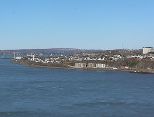 Traces of radiation from the crippled nuclear plant in Japan are being detected in states from California to Massachusetts, carried across the Pacific on broad rivers of wind. But state officials say there is no public health risk.
Traces of radiation from the crippled nuclear plant in Japan are being detected in states from California to Massachusetts, carried across the Pacific on broad rivers of wind. But state officials say there is no public health risk.
“The levels that we’re detecting are extremely, extremely low-we’re talking about many orders of magnitude below what we would consider a risk,” said Eric Matus, a radiation physicist for the Nevada State Health Division. Radiation has been detected at two monitoring sites in the state.
U.S. states, which aren’t recommending protective measures for the public, are reporting tiny amounts of radioactive iodine known as iodine-131 that is seen in the early stages of a nuclear reaction. It has a short half-life of eight days, meaning that in that time, half of it will have decayed to a non-radioactive state, a process that will continue until it is undetectable, Mr. Matus said.
Trace amounts of radiation are also being detected in Canada, South Korea, China and Germany, according to wire reports.
Prevailing winds routinely waft plumes of dust, coal-smoke, wild-fire soot, industrial grit and other microscopic particles from Asia to North America, several atmospheric scientists said.
Carried up by the rising warm air in the region around the damaged Fukushima plant, particles of radioactive isotopes such as iodine-131 and xenon-133 are being carried at about 50 miles per hour by winds blowing from west to east in a band of the atmosphere called the troposphere, about 6,500 feet to about 30,000 feet or more above the ground.
Generally, “the stuff will be spread in a long stream and, as it spreads, it becomes quite dilute,” said research scientist Tony VanCuren at the California Air Resources Board.
Under current conditions, particles from the Fukushima complex would take about a week or so to cross the Pacific. Typically, the particles will stay aloft until washed out of the air by rain or buffeted to lower altitude by turbulence, creating an unpredictable patchwork of fallout.
“Once it is over North America, rain storms can carry it back to the surface and that is what we are seeing happen,” said Jeff Masters, director of meteorology at Weather Underground Inc.
In South Carolina, five nuclear power plants in the area have found “barely detectable trace amounts of Iodine-131 in their air monitoring,” the S.C. Department of Health and Environmental Control said in an advisory Monday.
South Carolina officials attribute the presence of the radiation to the nuclear incident at the Fukushima nuclear plant in Japan, and nuclear plants in the area concur.
Monitors run by Duke Energy Corp., of Charlotte, N.C., picked up trace amounts of iodine-131 at three of the company’s nuclear stations Friday-one in North Carolina, and two in South Carolina-said Tina Worley, a Duke spokeswoman. “We have never had iodine-131 show up before, except during Chernobyl,” said Tina Worley, a Duke spokeswoman, referring to the 1986 Ukrainian nuclear disaster.
Minuscule amounts of radioactive iodine also showed up in Washington state, according to the Washington State Department of Health.
In Massachusetts and Pennsylvania, public officials said radiation found in rainwater last week posed no threat to drinking water. Pennsylvania repeatedly tested the drinking water from six regions in the state over the weekend, but detected no iodine-131, Pennsylvania Gov. Tom Corbett said in a statement Monday.
People might “get alarmed by making what would be an inappropriate connection from rainwater to drinking water,” Mr. Corbett said in a statement.
{Wall Street Journal/Matzav.com Newscenter}











